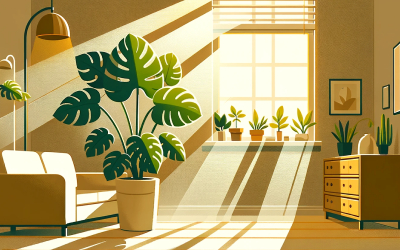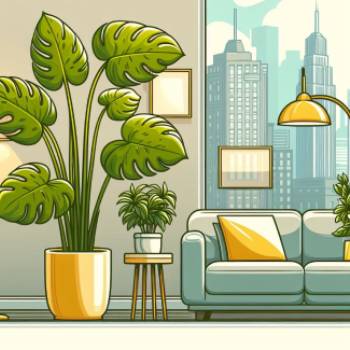| Snake Plant |
2-6 |
Thrives in indirect light; very drought-tolerant. |
| Spider Plant |
4-6 |
Prefers bright, indirect light; avoid direct sun to prevent leaf burn. |
| Pothos |
2-6 |
Adaptable; low light tolerant but prefers bright, indirect light. |
| Peace Lily |
2-5 |
Prefers low light; keep away from direct sunlight. |
| Aloe Vera |
6-8 |
Requires bright, direct sunlight; ideal for sunny windows. |
| Rubber Plant |
4-6 |
Prefers bright, indirect light but can tolerate lower light levels. |
| Fiddle Leaf Fig |
5-7 |
Needs bright, indirect light; avoid drafts and rotate regularly. |
| ZZ Plant |
2-3 |
Low light tolerant; ideal for office settings or rooms with few windows. |
| Philodendron |
3-6 |
Adaptable to various light conditions; prefers moderate, indirect light. |
| Swiss Cheese Plant |
3-6 |
Prefers bright, indirect light; avoid direct sun to prevent leaf scorching. |
| Boston Fern |
4-6 |
Prefers indirect light and high humidity; avoid direct sunlight. |
| Dracaena |
3-6 |
Prefers indirect light; can tolerate lower light levels. |
| Jade Plant |
4-6 |
Needs full sun to develop fully; ideal for a sunny windowsill. |
| Bromeliad |
3-6 |
Prefers bright, indirect sunlight; can tolerate a range of light conditions. |
| Anthurium |
3-6 |
Prefers bright, indirect light; avoid direct sun. |
| Calathea |
2-4 |
Prefers low to medium light; avoid direct sunlight. |
| Yucca |
6-8 |
Needs bright, direct light; ideal for sunny spots. |
| Croton |
6-8 |
Requires bright light to retain vibrant leaf colors. |
| Monstera |
3-6 |
Prefers bright to medium indirect light; avoid direct sun. |
| English Ivy |
4-6 |
Prefers bright, indirect light; can tolerate lower light levels. |
| African Violet |
4-6 |
Prefers bright, indirect light; avoid direct sun to protect leaves. |
| Bird of Paradise |
5-7 |
Needs bright light, including some direct sunlight. |
| Parlor Palm |
2-4 |
Prefers low light; avoid direct sunlight. |
| Prayer Plant |
2-4 |
Prefers low to medium, indirect light; avoid direct sun. |
| Haworthia |
4-6 |
Prefers bright light but not direct sunlight. |
| Dieffenbachia |
3-5 |
Prefers medium, indirect light; avoid direct sunlight. |
| Chinese Evergreen |
2-4 |
Tolerates low light; avoid direct sun. |
| Norfolk Island Pine |
3-5 |
Prefers bright, indirect light; avoid direct sunlight. |
| Schefflera |
4-6 |
Needs bright, indirect light; can tolerate some direct sun. |
| Cast Iron Plant |
2-3 |
Tolerates low light well; avoid direct sunlight. |
| Ponytail Palm |
6-8 |
Prefers bright light and can tolerate direct sunlight. |
| Sago Palm |
4-6 |
Prefers bright, indirect light; avoid prolonged direct sun. |
| Kentia Palm |
3-5 |
Prefers indirect light; can tolerate low light. |
| Asparagus Fern |
3-5 |
Prefers bright, indirect light; avoid direct sun. |
| Peperomia |
3-5 |
Prefers medium to bright indirect light; avoid direct sun. |
| Hoya |
4-6 |
Prefers bright, indirect light; can tolerate some direct sun. |
| Fittonia |
2-4 |
Prefers low to medium light; avoid direct sunlight. |
| Rattlesnake Plant |
2-4 |
Prefers low to medium light; avoid direct sunlight. |
| Spider Lily |
4-6 |
Prefers bright, indirect light; avoid direct sunlight. |
| Flamingo Flower |
3-5 |
Prefers bright, indirect light; avoid direct sun. |
| Golden Barrel Cactus |
6-8 |
Requires full sun to thrive. |
| String of Pearls |
4-6 |
Prefers bright, indirect light; avoid harsh direct sunlight. |
| Wax Plant |
4-6 |
Prefers bright, indirect light; can tolerate a few hours of direct sun. |
| Christmas cactus |
4-6 |
Prefers bright, indirect light; avoid direct sunlight. |
| Orchid |
3-5 |
Prefers bright, indirect light; avoid direct sun to protect leaves. |
| Cyclamen |
4-5 |
Prefers bright, indirect light; avoid direct sunlight. |
| Begonia |
3-6 |
Prefers bright, indirect light; some varieties can tolerate direct sun. |



